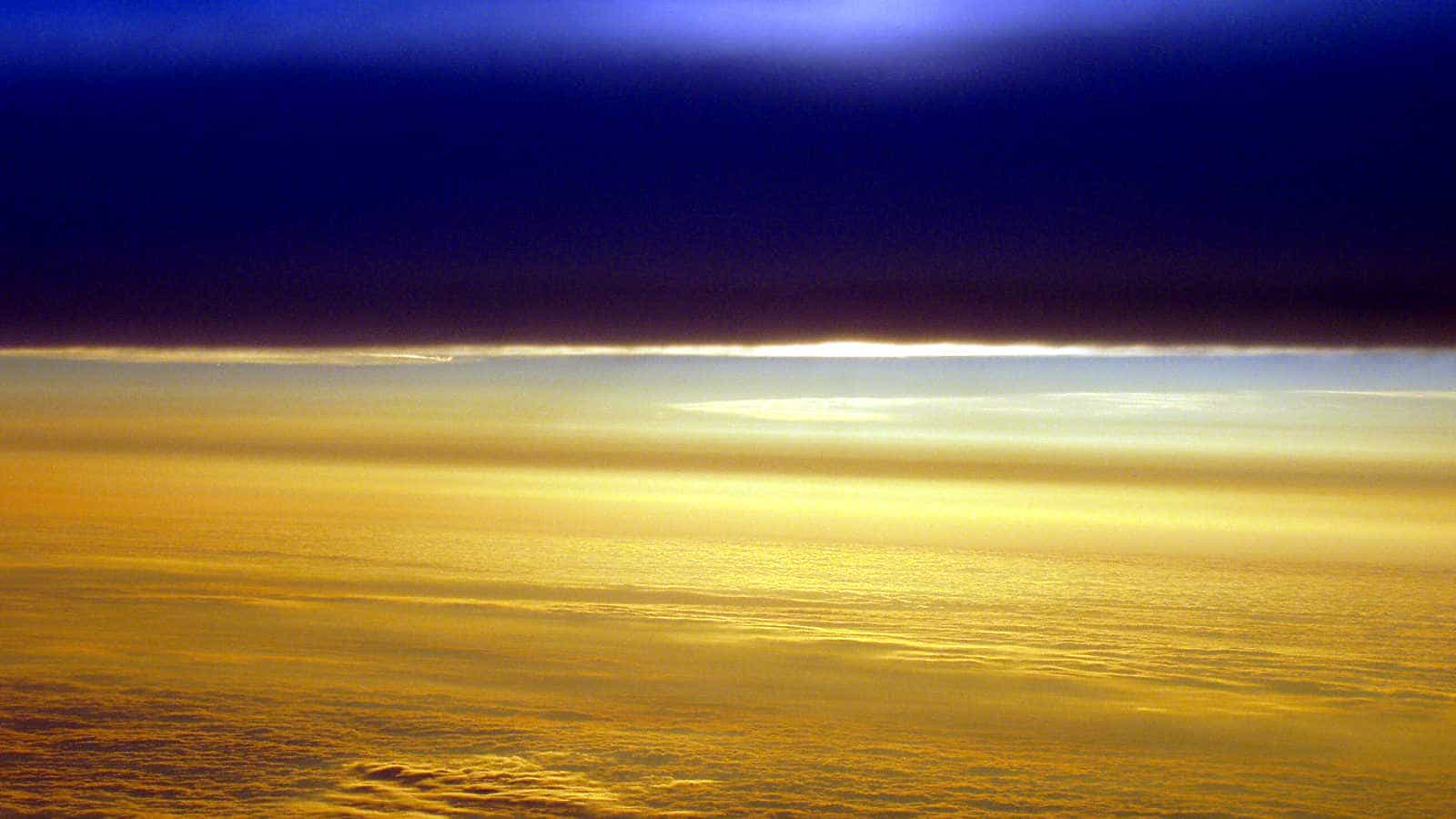Calculating the number of molecules in the air
2020-04-17 - Kiss J Gabor

Above the clouds
1. The atmosphere of Earth
The atmosphere of Earth is the layer of gases, commonly known as air. To calculate the number of molecules in, assume the following:
- the air pressure is 1 atm
- the air temperature is 273,15 K
- the composition of the mixture:
- 77,5106% nitrogen
- 20,7939% oxygen
- 0,9340% argon
- 0,7000% water vapor (strongly varies locally 0-3%)
- 0,0415% carbon dioxide
- 0,0200% other gases
I took the courage to put out exactly 100,0000 % of their amount
2. The molar mass of air
a. Calculate the weighted average of the molar masses of the components:
| Gas | molar mass (M) | part (%) |
|---|---|---|
| N2 | 14,007 × 2 = 28,014 g/mol | 77,5106 |
| O2 | 15,999 × 2 = 31,998 g/mol | 20,7939 |
| Ar | 39,948 g/mol | 0,9340 |
| H2O | 15,999 + 1,008 × 2 = 18,015 g/ml | 0,7000 |
| CO2 | 12,011 + 15,999 × 2 = 44,009 g/ml | 0,0415 |
| other gases | 20,000 g/ml | 0,0200 |
b. The calculation:
(77,5840×28,014 + 31,998×20,7205 + 39,948×0,9340 + 18,015×0,7000 + 44,009×0,0415 + 20,000×0,0200)/100
c. Mair3 = 28,889 g/mol .
Table of molar masses with different water content:
| Gas | pw 0.0 | pw 0.3 | pw 0.7 | pw 1.0 | pw 1,5 | pw 2,0 | pw 3,0 | pw 5,0 |
|---|---|---|---|---|---|---|---|---|
| N2 | 78,0625 | 77,8260 | 77,5106 | 77,2740 | 76,8798 | 76,4856 | 75,6971 | 74,1201 |
| O2 | 20,9420 | 20,8785 | 20,7939 | 20,7305 | 20,6247 | 20,5189 | 20,3074 | 19,8844 |
| Ar | 0,9340 | 0,9340 | 0,9340 | 0,9340 | 0,9340 | 0,9340 | 0,9340 | 0,9340 |
| H2O | 1. 0,0% | 2. 0,3% | 3. 0,7% | 4. 1,0% | 5. 1,5% | 6. 2,0% | 7. 3,0% | 8. 5,0% |
| CO2 | 0,0415 | 0,0415 | 0,0415 | 0,0415 | 0,0415 | 0,0415 | 0,0415 | 0,0415 |
| other | 0,0200 | 0,0200 | 0,0200 | 0,0200 | 0,0200 | 0,0200 | 0,0200 | 0,0200 |
| sum | 100 | 100 | 100 | 100 | 100 | 100 | 100 | 100 |
| Mair | 28,9648 | 28,9323 | 28,8889 | 28,8564 | 28,8022 | 28,7480 | 28,6396 | 28,4227 |
3. The molar volume of air
a. The standard temperature and pressure (STP):
In chemistry changed the definition of standard temperature and pressure (STP) in 1982:
Until 1982, STP was defined as a temperature of 273.15 K (0 °C, 32 °F) and an absolute pressure of exactly 1 atm (101.325 kPa).
Since 1982 STP is defined as a temperature of 273.15 K (0 °C, 32 °F) and an absolute pressure of exactly 105 Pa (100 kPa, 1 bar).
b. The normal temperature and pressure (NTP):
The USA’s National Institute of Standards and Technology (NIST) uses NTP. It is defined as a temperature of 293.15 K (20 °C, 68 °F) and an absolute pressure of 101.325 kPa (1 atm, 14.696 psi).
c. Avogadro’s law
Applying Avogadro’s law to a mole of gas:
Vmole= R × T / P, where
R - the „gas constant” 8.3144626 J/(K⋅mol),
T - the Temperature 273.15 K and
P - the Pressure 101.325 kPa.
the volume of one mole of gas: 22,41 litres/mol
Determine the number of molecules in
a.) 1 mole, i.e. 28,889 g, i.e. 22,41 litres of air
n = 6,022 x 1023 molecules
i.e. - id est
b.) 1 l, i.e. 1,2891 g, i.e. 1 dm3 of air
n = 6,022 x 1023 / 22,41 = 2,687 x 1022 molecules
c.) 1000 l 3, i.e. 1,2891 kg, i.e. 1 m3 of air
n = 1000 x 2,687×1022 = 2,687 x 1025 molecules
d.) 1 g, i.e. 0,7757 l, i.e. 0,7757 dm3 of air
n = 6,022 x 1023 / 28,889 = 2,085 x 1022 molecules
e.) 1 kg, i.e. 775,7 l, i.e. 0,7757 m3 of air
n = 1000 x 2,085×1022 = 2,085 x 1025 molecules
and so on...